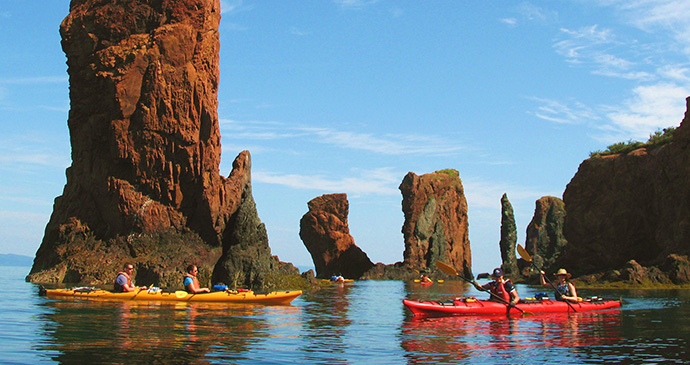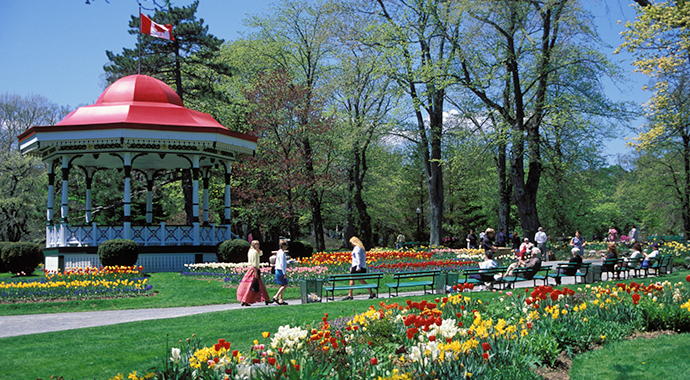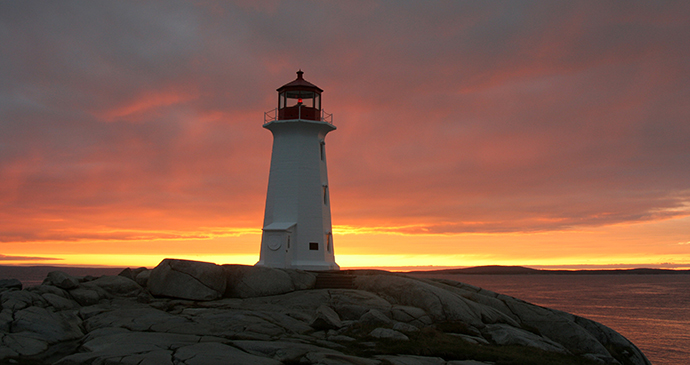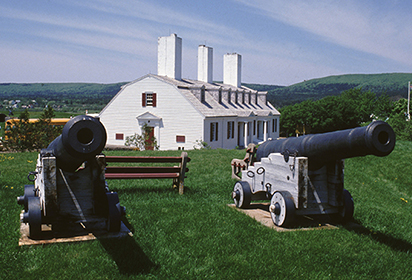Wrapped in 7,400km of coastline and virtually an island, Nova Scotia’s culture and heartbeat have always been shaped by the sea. Stories of pirates, buried treasure and ghost-ships abound, and there are stunningly located lighthouses to photograph.
David Orkin author of Nova Scotia: The Bradt Guide
Nova Scotia was once the refuge of pirates and privateers, but now it offers visitors a striking coastal landscape of Acadian fishing villages, soaring cliffs, and picturesque lighthouses. Wander through historic Old Town Lunenburg (one of three UNESCO World Heritage Sites) and discover the province’s British colonial past.
Outdoor enthusiasts are spoilt for choice with three national and over 130 provincial parks: search for moose and bald eagles on the many trails, or take to the water for superb sea kayaking. Nova Scotians are famous for their hospitality – sip local whisky at an 18th-century B&B or join hands at a Scottish ceilidh and dance the night away.
For more information, check out our guide to Nova Scotia
Food and drink in Nova Scotia
Food
Food visitors who enjoy seafood will be in gastronomic nirvana everywhere in Nova Scotia. The price may have crept up over the years, but fish (usually haddock) and chips is almost always done well, freshly cooked and not too greasy. You’ll also see a lot of flounder, halibut and salmon: plank (or planked) salmon – where the fish is slow-cooked on a wood plank (usually cedar) – is a highlight.
Then there’s the shellfish. Top of the pile is lobster – Nova Scotia is the world’s largest exporter of the crustacean, but more than enough remains to grace menus throughout the province. It is usually steamed or boiled in seawater, then served with butter – fancier methods of presentation, such as lobster thermidor or lobster Newburg, are seen less often. The larger supermarkets often have glass lobster tanks – at Sobeys stores you can choose a lobster and have it cooked whilst you wait, at no extra cost.
But the province’s waters offer other treats, too. Enjoy some of the world’s most delicious scallops, plus tasty mussels, oysters, crab and clams. Seafood chowder (a thick, chunky creamy seafood soup) can be a meal in itself. Those who choose not to eat, or want a change from, seafood need not worry. You will usually find a reasonable selection of chicken, turkey, pork, beef and (to a lesser degree) lamb dishes. Upmarket steak restaurants tend to use beef flown in from Alberta, Canada, or the USA.
Drink
You’ll find big-name Canadian and American beers everywhere, but even more popular are Nova Scotia-produced brands. Best known (and much-loved locally) is Keith’s, and the love affair continues even though the brewery is now owned by Labatt’s, a subsidiary of Anheuser-Busch InBev. Beer fans are spoilt for choice with an increasing number of microbreweries and brewpubs dotted around both Halifax and the rest of the province. Another tipple that you should sample is Nova Scotia’s single malt whisky, distilled on Cape Breton Island. Whisky is now also distilled in Guysborough and River John.
Other good distilleries include those in Lunenburg and Lequille (near Annapolis Royal). With an abundance of delicious apples, you won’t be surprised to hear that very good cider is produced locally. Visitors from the UK may get a surprise when they taste it though: unless called hard cider, it will be nothing stronger than sweet, refreshing apple juice.
Health and safety in Nova Scotia
Health
The standard of public health in Canada is excellent, but very expensive for non-residents. If you become ill in Nova Scotia, for minor ailments, seek out a pharmacy. If it is something more serious, your next step is to go to one of the few walk-in clinics or to the emergency department of a hospital. You will have to pay at both to use the facilities and to see a doctor, and for any treatment and/or medicines that may be required. It is a similar story for emergency dental work. Consequently, it would be foolhardy to visit Nova Scotia (and anywhere in North America) without comprehensive medical insurance (check that your travel insurance policy includes adequate cover).
If you take prescription medicines to Nova Scotia, make sure that they are in their original packaging (with a label that specifies what they are and that they are being used under prescription). If that is not possible, carry a copy of the prescription or a letter from your doctor. Otherwise, they may be confiscated by customs officials. No vaccinations are legally required, but it is always wise to be up to date with routine vaccinations such as diphtheria, tetanus and polio. Tap water is safe to drink.
Travel clinics and health information
A full list of current travel clinic websites worldwide is available on www.istm.org. For other journey preparation information, consult www.travelhealthpro.org.uk (UK) or http://wwwnc.cdc.gov/travel/ (US). Information about various medications may be found on www.netdoctor.co.uk/travel. All advice found online should be used in conjunction with expert advice received prior to or during travel.
Safety
Canada is politically stable and one of the world’s safer places, and – Halifax and Dartmouth apart – Nova Scotia’s crime rates are about average for the country (they have been on a downward trend for the last few years). Halifax (including Dartmouth) is second to Winnipeg as the Canadian city with the highest murder rate, and violent crime figures in the city are bucking the national trend and are on the increase. Having said that, you would have to be exceedingly unlucky to be in the wrong place at the wrong time.
Crimes tend to be a different story outside the city. Rightly or wrongly, many people in rural areas still don’t lock their doors. I don’t suggest that you follow their example, however romantic the notion might be.
Violent crimes are infrequent; far more common is petty theft. Some parts of the big urban areas are troubled by youth crime, often drug- or drink-inspired, but probably to a lesser degree than in equivalent cities in Europe or the USA.
Outside the urban centres, things seem so laid-back that it is easy to forget common sense. For instance, if you must leave valuable items in your car unattended, keep them out of sight, preferably locked in the vehicle’s boot. And wherever you are in the world, carrying large amounts of cash around isn’t a great idea.
Travel and visas in Nova Scotia
Visas
This information is correct at the time of writing, but rules and practices change, so do check the current situation (www.cic.gc.ca/english/visit/tourist.asp) before buying your ticket. As of 29 September 2016, most international visitors intending to fly to (or transit) Canada need an Electronic Travel Authorisation (eTA). Exceptions include US citizens, and travellers with a valid Canadian visa. At the time of writing, if you are entering Canada by land or sea, aneTA is not required.
eTAs will allow the Canadian authorities to screen travellers before they arrive. The eTA is electronically linked to your passport and is valid for five years or until your passport expires, whichever comes first. As it is passport-linked, you must travel using the passport with which you applied for your eTA.
Getting there and away
Most European visitors arrive into Nova Scotia by air, flying into Halifax Robert L Stanfield International Airport. For those coming from (or going to) other parts of Canada, there are a few other options: one rail connection, and two road crossings from the neighbouring province of New Brunswick (itself connected by road to the Canadian province of Quebec, and to Maine in the United States). There is a ferry connection with Maine, USA, as well as ones with New Brunswick, Prince Edward Island and Newfoundland.
Travellers from the USA have the choice of flying, taking the ferry from Portland, Maine, driving to Saint John, New Brunswick, and taking the ferry from there, driving through New Brunswick to take the land route in to Nova Scotia, or some combination of the above (eg: ferry one way, drive the other). By road, Portland to Saint John is just over 480km by road: Portland to the New Brunswick–Nova Scotia border, near Amherst, is 750km.
By air
Air Canada is the only airline to offer non-stop year-round flights between the UK and Nova Scotia (London Heathrow to Halifax). Between spring and early autumn, Canadian airline Westjet offers direct flights between both Glasgow and Dublin and Halifax. Flying time from London to Halifax is around 6½ hours (the Gulf Stream winds mean that the return journey is usually about 45 minutes quicker). If you are having problems finding seats at a competitive fare, try looking beyond direct flights – more options exist if you are prepared to change planes. Westjet, for example, often offers good deals from London Gatwick to Halifax changing planes in St John’s (Newfoundland) or Toronto. However, it’s worth comparing any savings in cost against the extra time and inconvenience the stopovers will incur. The most expensive time to fly is in July and August.
If you’re coming from elsewhere in Canada, options also exist in the summer to fly direct to Sydney (on Cape Breton Island) from Toronto.
In addition to the daily (except where specified) direct flights between US airports and Halifax, if you are prepared to change planes, there are more possibilities. Incidentally, if you are flying directly to the USA, Halifax Airport has a US Customs pre-clearance facility allowing you to go through US Customs and Border Protection before your flight – saving quite a bit of time at the other end (note though that this is not offered 24/7).
There are no direct flights between Australia and Nova Scotia – you will have to change planes at least twice. A couple of airlines offer through fares, for example Air Canada and United. It is often cheaper to buy a ticket to (say) New York, and a separate ticket New York–Halifax.
By car
Whether driving from the USA or Canada (unless you take a ferry; see opposite), you’ll pass through New Brunswick and cross in to Nova Scotia near Amherst. From there it is 215km/134 miles – about a 2½–3-hour drive – to Halifax. Montreal is about 1,250km/777 miles from Halifax by road, and (again if you don’t take a ferry) Boston is 1,120km/700 miles. For more on driving in Nova Scotia.
By coach
Maritime Bus took over long-distance coach services in December 2012. They usually operate three services daily in each direction between Halifax (calling at various places in Nova Scotia including Dartmouth, Halifax Airport, Truro and Amherst) and Sackville and Moncton (both in New Brunswick): Halifax to Moncton usually takes just over 4 hours. From Moncton there are connecting services through New Brunswick to Quebec. Those wishing to connect to/from Prince Edward Island should change buses in Amherst.
Advance Shuttle operates 11-passenger air-conditioned vans once daily in each direction between Nova Scotia and Prince Edward Island (4–5hrs; CAN$69 one-way) via the Confederation Bridge (which connects New Brunswick and Prince Edward Island). The route is Charlottetown–Summerside–Borden (all in Prince Edward Island), then Amherst–Oxford–Truro–Elmsdale–Enfi eld–Halifax Airport–Halifax City–Dartmouth.
By train
VIA Rail operates an overnight train, The Ocean, three times a week between Montreal and Halifax. The train leaves Montreal in the evening, travels via Moncton and New Brunswick, arriving in Halifax mid afternoon. In the other direction, afternoon departures from Halifax reach Montreal the next morning.
Year-round, the train offers standard economy class and sleeper class; the latter affords you a bed in private accommodation. Between mid June and mid October, you can also travel in sleeper touring class. Extra benefits, instead of standard sleeper class, include on-train presentations with cultural and historical insights to the Maritimes, exclusive access to the train’s lounges and panoramic section of the luxurious Park Car, breakfast, lunch and a three-course dinner. Regular fares are CAN$218 each way in economy class, but a limited number of no change, no refund ‘Economy Saver’ tickets are sold for each journey at just CAN$135. Look out, too, for special sales.
By sea
Bay Ferries operates The CAT, a highspeed catamaran ferry, daily (each way) between Portland, Maine, and Yarmouth. The 2016 season ran from 15 June to 1 October with a morning departure from Yarmouth and an afternoon departure from Portland (5½hrs; US$107 one-way per passenger, from US$199 one-way per vehicle excluding driver).
The company also operates Digby–Saint John (New Brunswick) on the Fundy Rose year-round (1–2 times daily; 3hrs; passenger fares from CAN$46 one-way, vehicle cost from CAN$112); and Caribou (near Pictou)–Wood Island (Prince Edward Island) on NFL Ferries MV Confederation and MV Holiday Island from May to mid December (3–8 times daily; 75mins; fares from CAN$19 round-trip for passengers, from CAN$81 round-trip – including passengers – for a vehicle).
Marine Atlantic offers two connections between Nova Scotia’s Cape Breton Island and the Canadian province of Newfoundland: North Sydney–Port aux Basques (Newfoundland) year-round (6–8hrs; passenger fares from CAN$43, vehicle from CAN$113); and North Sydney–Argentia (Newfoundland) three sailings a week from late June to late September (16hrs; passenger fares from CAN$115, vehicle from CAN$232). Fares shown are one-way. Note that the vehicle rate does not include driver or passengers.
Getting around
It is easy to travel around Nova Scotia – if you have a vehicle. Sadly, public transport is quite limited, and virtually non-existent in many areas.
By air
Air Canada offers a few flights a day between Halifax and Sydney, Cape Breton Island, as does Westjet.
By car
For the freedom it gives you, the (generally) good roads, and – compared with much of Europe and urban North America – the (generally) very light traffic, driving is by far the best way to get around the province. British motorists, used to driving on the left, will quickly adapt to driving on the right. Most drivers in Nova Scotia are courteous, patient and observant of speed limits. Outside downtown Halifax, parking is rarely a problem.
Traffic jams are not unheard of, particularly during rush hour on the approaches to and from Halifax and Dartmouth, and the motorway (Hwy 102) which links them with the airport.
Everywhere is well within a day’s drive of Halifax. You could easily reach Yarmouth in three–four hours, and Sydney (on the east coast of Cape Breton Island) in four–five hours. But Nova Scotia is not about rushing from A to B: in fact, quite the opposite. Where possible, try to avoid the motorways and aim instead for the smaller, often much more scenic – albeit slower – alternatives. Try to allow far more time than distances on the map might suggest. One of the joys of touring the province is discovering what lies beyond the main roads: making side trips down virtually uninhabited peninsulas, trying to spot whales from a headland, stopping to pick your own strawberries, to wander deserted beaches, take in the view from a look-out, or to watch boats bobbing in the harbour at tiny fishing villages.
By coach
With the exceptions of one section of railway line (serving just four stations thrice-weekly), a few local public bus services and private shuttle companies, Nova Scotia’s primary public transport network consists of coach services off ered by Maritime Bus. The network includes a daily (or more frequent) service in each direction between Halifax and Kentville stopping at Dartmouth, Lower Sackville, Falmouth (for Windsor), Wolfville and New Minas. Halifax is also connected a few times daily with Dartmouth, Halifax Airport, Truro, Amherst and Moncton, New Brunswick.
By train
Passenger rail travel is very limited, but possible: three days a week, VIA Rail runs a service between Montreal, Quebec and Halifax, and this stops at Amherst, Springhill Junction and Truro.
By bike
Cyclists are permitted on all Nova Scotia’s roads, including motorways. Helmets must be worn. When riding at night you must use a white front light and a red rear reflector (a rear-facing, flashing red light is acceptable). Reflectors and reflective clothing are also advisable. Most airlines allow bikes as checked baggage, but will have rules as to how the bike should be packed: a handling fee may apply. Check and re-check before booking your ticket.
By hitchhiking
Hitchhiking is not allowed on 100-series major (controlled-access) motorways. Whilst chances are that all will go well and that you’ll meet some interesting people, climbing into a stranger’s vehicle always carries some degree of risk. Police may also pull over and chat to hitchers to check that they are not missing persons or runaways. As in much of the world, hitching isn’t as easy (or as safe) as it used to be – and the release in 2007 of a remake of a 1986 film, The Hitcher, hasn’t helped. Storylines of psychopathic, murderous hitchhikers don’t exactly encourage drivers to pick up strangers.
When to visit Nova Scotia
Whilst there are reasons to visit Nova Scotia in the winter – a few festivals, some wildlife-spotting opportunities, and some minor ski resorts – there can be a lot of snow and it can get very cold. Most attractions, many eateries and places to stay outside the biggest urban centres are closed. More doors begin to open after Canadian Mother’s Day (the second Sunday in May).
Realistically, those considering a visit to the province should concentrate on the period between May and late October. May is quiet, though the days are long and the weather is warming up. Later in the month, apple blossom covers much of the Annapolis Valley, and flowers begin to bloom. By the beginning of June the weather is generally good for outdoor activities such as hiking, cycling, swimming, kayaking, etc, though late spring and early summer can be foggy. The golf courses and most provincial parks are open, more attractions are opening by the day, the festival season is well underway, and by the middle of June whale-watching trips have begun.
July, August and early September are relatively busy; everything is open, though high-season pricing is in effect. Those who enjoy swimming in the sea will find that August and early September offer the warmest air and water temperatures. If you will be visiting at these times, book your accommodation well in advance, and bear in mind that things will be busier. You can still find uncrowded beaches – though you’ll have to walk away from the parking areas – but bear in mind that a crowded beach by Nova Scotia standards would seem relatively quiet in many other places.
Climate
Nova Scotia lies within the Northern Temperate Zone. The climate is more typically continental than maritime, although the sea has an attenuating effect on the temperature highs and lows. Cape Breton Island experiences much more extreme weather patterns than mainland Nova Scotia. In general, sea temperatures are too low for enjoyable swimming: the main exceptions to this are the coastal waters of the Northumberland Strait and northwest Cape Breton Island, particularly in August.
Annual precipitation averages 1,200mm, falling mainly as rain during autumn and as snow in winter. Boosting the average are the highlands of Cape Breton Island (an average of over 1,600mm of precipitation per year) and the southwest (1,500mm): in comparison, the Northumberland Strait receives less than 1,000mm a year. The summer of 2016 was particularly dry, with the southwest of the province experiencing its lowest rainfall levels for more than 70 years.
The merging of warm, moisture-laden air above the Gulf Stream with the far cooler air above the Labrador Current results in a lot of fog: this can often blanket coastal regions, particularly in the morning between mid spring and early summer. The good news is that the fog is often localised, and more often than not dissipates by late morning. Some of the foggiest parts of the province are Halifax, Yarmouth, Canso, Sydney and Sable Island.
Although most fizzle out before they reach Nova Scotia, some hurricanes and tropical storms do stay the distance and sweep across the province, uprooting trees, knocking down power lines and washing away bridges. The worst in recent years was Hurricane Juan (September 2003) which caused vast amounts of damage. Environment Canada’s website offers weather forecasts for more than 40 towns across the province.
What to see and do in Nova Scotia
Annapolis Royal
It is hard not to like Annapolis Royal. Firstly, it has a delightful setting on the Annapolis Basin shore – and wonderful views across the water to the pretty village of Granville Ferry from a boardwalk with benches, picnic tables and a lighthouse. The town (with a population of approximately 500) has a tree-lined main street, one end of which is dotted with gracious mansions, many of which help make up what is the largest concentration of heritage buildings in Nova Scotia, with more than 120 municipally registered properties, 20 provincial heritage properties and five federally designated properties. Several of these house some of the province’s best inns and B&Bs.
You’ll find lovely gardens to stroll through and waterside trails to wander, and you can also visit North America’s first tidal power-generating plant. There are galleries and a theatre with a good year-round programme. You can visit a historical site dating back four centuries, take a candlelit graveyard tour, wander around a museum housed in a 300-year-old building, or amble through an early 18th-century cemetery. Although all of these can be reached easily on foot, a short drive will take you to the site of one of the earliest permanent European settlements in North America, a good golf course, a beautiful hiking trail to the Bay of Fundy shore, or Nova Scotia’s biggest theme park. Despite all this, Annapolis Royal only gets really busy during some of the bigger festivals (and on sunny summer Saturday mornings for the market).
Don’t come to ‘Canada’s birthplace’ for the nightlife (though there is a friendly little pub, the evening’s best entertainment is a candlelit graveyard walking tour), but do come to soak up the history and unique atmosphere. And note that the town doesn’t end at the junction of St George Street and Drury Lane: continue less than a hundred metres further on St George Street to see a couple of interesting shops (one with a café), a nice children’s playground, and the O’Dell Museum.
Cape Breton Island
Joined to the mainland since 1955 by the 2km-long Canso Causeway that crosses the narrow Strait of Canso, Cape Breton Island has a population of just under 150,000. Approximately 175km long and 135km wide, it covers 10,300km². At the island’s core is the vast 260km² saltwater Bras d’Or Lake, to the northeast two natural passages connect the lake to the open sea, and in the southwest a short canal constructed in the 1850s and 1860s performs the same purpose. Cape Breton Island has the province’s largest bald eagle population, many of which nest along the lake’s shoreline.
Rugged highlands occupy much of the northern portion of Cape Breton Island: here you’ll find the Cape Breton Highlands National Park, a region of deep, forested canyons, and magnificent coastal cliffs – and the best place in the province to see moose in the wild. This area of natural wonders is accessed by one of the world’s great scenic drives, the 300km Cabot Trail. But don’t just see it all through your car window – get out of your vehicle to hike, bike, kayak, play one of the superb golf courses, take a whale-watching trip or just relax on one of the beautiful beaches. Take a detour to remote Meat Cove, or wander the streets of the Trail’s de facto capital, lakeside Baddeck, where Alexander Graham Bell was a summer resident for more than 35 years.
Set on a magnificent harbour on the east coast, the port of Sydney is by far the biggest urban area: with the surrounding communities it makes up what is still called Industrial Cape Breton, a region largely built on coal mining and steel manufacturing which is home to over 70% of the island’s population.
The island’s major manmade attraction is in the southeast, a wonderful reconstruction of the Fortress of Louisbourg which played a major part in Nova Scotia’s Anglo-French conflicts in the mid 18th century. In the southwest soak up the sleepy pastoral beauty and pretty backroads of Isle Madame.
But man has contributed another particular highlight of any visit to Cape Breton Island, part of the legacy left by the 50,000 Highland Scots who came here and settled in the late 18th and early 19th centuries – joyous Celtic music and dancing. Be sure to go to a ceilidh whilst in Cape Breton Island – or better still, try to time your visit to coincide with the Celtic Colours International Festival, a fantastic blend of traditional music, dancing and nature’s splendour.

Cape Chignecto Provincial Park
Covering a vast area of 4,200ha, Cape Chignecto is Nova Scotia’s largest provincial park and should certainly not be missed by lovers of the wild outdoors. It is located on an arrowshaped headland pointing in to the Bay of Fundy, flanked by Chignecto Bay and the Minas Basin. Although encompassing 29km of pristine coastline, much of the park sits high above the huge tides, with some cliff s reaching 185m. In the water below, nature has created a range of natural sculptures, such as the Three Sisters, huge misshapen sea stacks.
The park has no roads, and to stay within its boundaries you’ll have to camp. Partly for these reasons – and the somewhat ‘out-of-the-way’ location – Cape Chignecto is still something of a hidden gem.
Ten marked trails give access to the natural highlights. These range from quick jaunts to the beach from the Red Rocks visitor centre, or the Three Sisters look-out from Eatonville Beach, to challenging all-day hikes that should only be attempted by experienced hikers, such as the spectacular Red Rocks visitor centre–Refugee Cove trail. The big one is a multi-day circuit of the Cape. The longer hikes are all likely to involve climbing steep slopes and following vertiginous cliff side paths, but the wonderful nature, magnificent scenery and spectacular views are a just reward.
Expect to see yellow birch, American beech, Eastern hemlock, balsam fir, sugar maple and white and red spruce. For much of the summer, you’ll also see wild flowers. Whilst the peninsula is home to bobcats, moose and black bear, these are very rarely encountered; far more common are whitetail deer, rabbit and hare. Grey seals can often be seen in late summer, basking on rocks in the coves.
Digby Neck
Close to Digby, what looks on a map like a thin, skeletal finger (the last two ‘bones’ are actually islands) stretches for almost 75km and separates the Bay of Fundy from St Marys Bay. Geologically, the Digby Neck, rarely more than 3km wide, is a continuation of North Mountain, which separates the Annapolis River Valley from the Bay of Fundy. Both Brier and Long islands are made up of Jurassic basalt lava – as the lava cooled, it sometimes formed vertical polygonal columns such as Balancing Rock.
The pace of life in Nova Scotia is generally pretty relaxed, but if you want to slow down even more, enjoy natural splendour, and take a holiday from your holiday, this beautiful area is worth some time. A line of wind turbines is a relatively recent addition to the landscape.
There are few services, but just enough: pretty villages and good hiking, some of the province’s best birding opportunities and what may well be the best whale-watching opportunities along the entire east coast of North America. Although the majority of visitors drive straight to their whale-watching trip and (when it is over) drive back again, try to allow yourself more time to explore this beautiful region.
Fortress of Louisbourg
Park directly on site via Entrance 2 between mid September and mid June, or park (for free) at the visitor centre at other times, buy your ticket and take the 7-minute bus ride to the fortress area. The reconstructed area alone sprawls across some 10ha, with dozens of buildings to visit and numerous activities to entertain you.
Theme centres and exhibits abound, each of which offers insight into a different part of the history and everyday life of the fortress in the 1740s. Whereas in many other living museums you’ll see a few interpreters demonstrating a few traditional techniques, when everything is up and running Louisbourg seems alive with men, women and children in costume, only too prepared to interact – in character – with visitors. Strikingly obvious is the class difference at the time, with both fine houses for the gentry, and simple spartan dwellings for the have-nots.
See building techniques demonstrated, nail making, open-hearth cooking and lace making. Observe military exercises and in July and August fire a cannon (extra CAN$55.20) or a real musket (extra CAN$36.80) whilst in period costume. Herbs and vegetables are tended in tidy back gardens.
Join a guided walking tour or one of the various programmes, including the story and tasting of rum (check in advance for tour times), or use the site map to explore on your own. Be prepared for windy and/or wet weather, and a lot of walking. Allow far more time than you usually would for a ‘standard’ historical site or living museum. Get in the mood, and go back more than three centuries!
Halifax’s Public Gardens make for a pleasant afternoon stroll © Nova Scotia Tourism
Halifax
The province’s most important metropolis was once the major point of entry to Canada for more than a million immigrants and refugees, and the port remains a busy centre for shipping today. Much attention focuses on the bustling waterfront, and traffic in the harbour is a mix of ferries, yachts, tugs, container ships, naval vessels and ocean cruisers.
A range of museums, galleries and indoor attractions – not to mention shopping, particularly on lively Spring Garden Road – will occupy you if the weather isn’t at its best, but when the sun comes out and the mercury rises you’ll want to wander the beautiful Halifax Public Gardens and hike along the seafront at Point Pleasant Park, take a boat on the harbour, or go for a picnic. Summer is the time for an array of festivals, many of which are free.
Halifax’s raison d’être was its harbour, which is still a major part of life for Halifax, Dartmouth and Bedford. At the mouth of the harbour are Chebucto Head on the Halifax side and Hartlen Point on the Dartmouth side. Herring Cove Road and Purcells Cove Road lead towards the downtown area from Chebucto Head, passing fjord-like Northwest Arm, and on the Dartmouth side, Shore Road and Eastern Passage Road run close to the waterfront, with McNabs and Lawlor islands just offshore.
Whilst first impressions will suggest that Halifax is friendly, charming and relaxed, dig deeper and you’ll also find a well-developed music scene, lively pubs, and restaurants and bars to suit most palates and budgets. The two universities keep the atmosphere youthful – but rarely rowdy.
Lunenburg
All in all, Lunenburg – roughly equidistant from Halifax and Shelburne – is one of Nova Scotia’s most interesting and appealing towns. Established in 1753, the original town layout has been maintained and many original wooden buildings preserved, with eight dating back to the 18th century. As the best-surviving example of a planned British colonial settlement in North America, Lunenburg’s Old Town section was designated a national historic district by the Canadian government, and in 1995 it was declared a cultural UNESCO World Heritage site, one of only eight in the whole of Canada.
The Old Town sits on a steep hillside overlooking the harbour, and as you drive – or better still, walk – through you’ll realise just how steep some of the narrow streets are. A guided walking tour should satisfy those wishing to dig deeper, and if walking is not for you, you can even see the sights by horse and carriage. Also within an easy drive or cycle ride are several beautiful small forested peninsulas and two tiny photogenic fishing villages well worth exploring.
Many of the well-preserved brightly painted historical buildings now house inns, cafés, restaurants, shops and a seemingly ever-increasing number of galleries. Long ago, as it prospered and grew, the town spread beyond the original grid. In residential streets a few minutes’ walk away are more magnificent homes, this time on much bigger plots of land. Some – with large lawns and beautiful gardens – are now B&Bs or inns. In the Old Town area, most of the shops, museums and services are in the rectangle bounded by the waterfront, Lincoln, Cornwallis and Hopson streets.
Today, the fishing industry may have dried up here, but the marine traditions and its seafaring heritage live on proudly. The Fisheries Museum of the Atlantic will help you understand not just Lunenburg, but coastal communities throughout the province. A dory shop on the waterfront has been making small wooden fishing boats since 1895, and traditional methods are still used. The town is the homeport of the Bluenose II, and tall ships often grace the picturesque harbour.
Peggys Cove Lighthouse at sunset © goofyfoottaka, Shutterstock
Peggys Cove Lighthouse
Indubitably, Peggys Cove (population: 120) is a very picturesque fishing village with an incredibly photogenic octagonal lighthouse overlooking a perfect little harbour. The white c1914 lighthouse stands atop granite worn smooth by thousands of years of mighty waves. Just below it, weathered fishing shacks on stilts, stacks of lobster pots and piles of fishing nets line the tiny cove where colourful fishing boats bob in the water. Bright green vegetation on the banks above contrasts with the blue of the sea, and the lapping of the waves, rustle of the wind, and squawking seagulls provide the soundtrack.
Incidentally, the lighthouse received a fresh coat of paint in 2012: when the federal and provincial governments couldn’t agree on whose responsibility it was to keep the lighthouse looking good, locals bonded together and did the job themselves.
So what’s not to like? The problem is that this is no ‘off-the-beaten-track’ secret. T Morris Longstreth wrote in 1934’s To Nova Scotia: ‘I am afraid that Peggys Cove will meet a tragic end. She will be thrown to the tourists.’ In summer the same pleasure you get from thinking how quiet, unspoilt and (relatively) tourist-free the rest of Nova Scotia is can be soured by having to share the beauty of this little village with hordes of other visitors, many of whom arrive by the busload. That doesn’t mean that the place is swamped with tacky souvenir shops or rip-off bars, restaurants and hotels: on the contrary, services are limited. There’s an interesting gallery, a craft shop or two, a restaurant, a couple of ice cream shops – and two car parks to cater for a lot of visitors.
Tangier
The rugged Eastern Shore, where an isolated band of islands stretches from Clam Harbour to Canso. This forgotten wilderness forms a compelling mix of natural and human history. Some of these outposts are just tiny specks, scarcely breathing air at high water, whilst others are huge forest-covered expanses that dominate the horizon, and beckon to the inquisitive traveller. Explore abandoned lighthouses and shipwrecks, uncover those vanishing signs of our own transient history, or camp on a deserted isle where your only companions are the seals and the seabirds, far from the summer bustle. Tangier is an ideal place from which to start.
This small community (population: 115) once serviced several gold mines. It is now home to an excellent sea kayaking company, Coastal Adventures, which is also one of the only places offering kayak rentals along the entire Eastern Shore. Come for expert advice, half- and full-day kayak excursions that include visits to uninhabited islands, and a range of longer (multi-day) packages. Also just off Highway 7 at Mason Point Road is the simple Prince Alfred Arch, erected to commemorate the (1861) visit to the local gold mine by Queen Victoria’s son.
The Cabot Trail
The Cabot Trail is the official name for a road that loops around northern Cape Breton Island. This region is justly renowned for its stunning unspoilt beauty and regularly features high on lists of the world’s best scenic drives.
The most spectacular stretch of the approximately 300km trail is the 115km between Chéticamp and Ingonish Beach, much of which passes through the Cape Breton Highlands National Park. From early summer well into autumn, pilot, minke, fin and humpback whales come to feed in the Gulf of St Lawrence and off the northern tip of Cape Breton Island. Whale-watching tours depart from Chéticamp, Pleasant Bay, Bay St Lawrence and the Ingonishes.
The national park apart, there are many other beautiful sections of the Cabot Trail, such as the drive through the Margaree Valley. There are also some pretty side trips such as the one from Cape North to Meat Cove.
This is not a drive to be rushed: plan to stay a couple of nights (ideally more) en route to have time to walk some trails, appreciate the look-outs, take a side trip or two, look round Baddeck, try your hand at sea kayaking, go whale watching, cycling, or just relax on the beach.
Tour Lunenburg on the Bluenose II
There had long been competition between fishing fleets from Lunenburg and Gloucester, Massachusetts, but so keen was their rivalry that in 1920, the Halifax Herald sponsored an annual race for deep-sea fishing schooners from the two fleets. When the Americans won, Canadian pride was hurt: a superior vessel had to be built in time for the next year’s competition.
They came up with Bluenose, which not only regained the trophy, but won it for 18 years in succession until World War II loomed, and the race was suspended. New steel-hulled trawlers rendered wooden fishing vessels redundant and in 1942, the Bluenose was sold to carry freight in the Caribbean. Four years later, she foundered and was lost on a Haitian reef. For many years, this undefeated champion was featured on the back of the Canadian dime (10-cent piece): she is still remembered on Nova Scotia licence plates.
In 1963, the replica Bluenose II was built to the original plans by many of the original workers in the same shipyard as the original. From 1971, she sailed countless thousands of miles as Nova Scotia’s floating ambassador.
In the last few years, the vessel has undergone a major repair and restoration programme (which went millions of dollars over budget), and for much of the time has been out of commission.
Related books
For more information, see our guide to Nova Scotia:
Related articles
Fall is one of the most spectacular times to visit Nova Scotia.
Sit back and enjoy this kaleidoscope of colours.
Look at the stars, look how they shine for you.
Nova Scotia is very rich in historical sites compared with much of North America.






